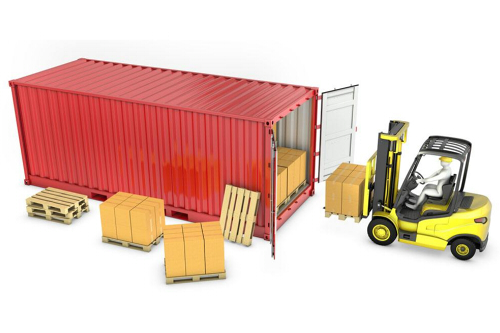Why Have Containers Boosted Trade So Much?
为何集装箱大规模地促进了世界贸易?
At first glance they may just appear to be humble metal boxes. But containers – uniform boxes that can be easily moved between lorry, train and ship – have reshaped global trade over the past few decades. Why have containers boosted trade so much?
一眼看去,集装箱仅如同一个个简陋的金属箱子。然而,集装箱(这种大小有标准的“箱子”,能够在卡车、火车以及轮船间便利地运输)在过去的数十年里改变了世界贸易格局。集装箱为什么能在世界贸易发展中起到如此大的推力呢?
Uniform metal containers were invented by Malcom McLean, an American trucking magnate, in 1956. Before then goods were shipped as they had been for centuries. Crammed in to the hold of a ship, loose cargo in wooden crates would be loaded and unloaded by vast crews of dockworkers. The process was unwieldy, unreliable and so slow that ships often spent longer docked than they did at sea. Theft of transported goods was rampant: as an old joke put it, dock workers used to earn “$20 a day and all the Scotch you could carry home.”
1956年,美国货运业巨头马尔科姆·麦克林发明了标准化的集装箱。在此之前,传统的货物运载方式已经延续了数世纪。散货通常装入木箱,满满地塞进货轮,再由大量码头工人进行装卸作业。整个过程显得那么的笨拙,那么的不可靠,那么的缓慢以至于运输船只停港逗留时间比起海上时间还要长。货物运输过程中盗窃猖獗,正如一句听厌了的笑话所描述的那样:码头工人们经常赚到的是“20块一天呀!苏格兰威士忌随你拿!”
Containers changed this in several ways. The price of everything fell, starting with the cost of loading and unloading. When Mr McLean looked at the costs of his first container ship, he found that it cost $0.16 per tonne to load compared with $5.83 per tonne for loose cargo. Between 1965 and 1970 the amount of capital locked up per tonne of inventory in transit between Hamburg to Sydney fell by half. Because containers were packed and sealed at the factory, losses to theft plummeted, which in turn drastically reduced insurance costs. More could also be loaded: in 1965 dock labour could move only 1.7 tonnes per hour onto a cargo ship; five years later they could load 30 tonnes in an hour. As a consequence, ships could get bigger and more efficient while still spending less time in port. As containers made inland distribution by train and lorry easier, ports became bigger and fewer in number. (In 1965 there were 11 loading ports in Europe; by 1970 there were three.) This, along with increased productivity, meant fewer dockworkers were needed, undermining their bargaining power and reducing the number of strikes.
集装箱在一些层面改变了这一切。随着装卸成本的下降导致了所运输货物价格的下跌。当麦克林查看他首批集装箱货运船成本的时候,发现相对于散装货装货成本为5.83美元/吨,集装箱装货每吨成本为0.16美元。1965年至1970年间,汉堡至悉尼海运途中存货成本按每吨计跌了一半。由于集装箱在工厂里面装货密封,盗窃损失大幅减少,这又反过来减少了保险费用。愈来愈多的货物能够被装到船上:1965年的时候,每小时仅能运载1.7吨货物至货轮上;五年以后,每小时能运载30吨!结果导致了货轮吨位越来越大,更有效率,同时节省了很多停留在港口的时间。随着集装箱使得内陆火车和卡车物流运输更便利,港口规模变得更大了,也更集中了。(1965年,欧洲有十一个装货港;1970年,变成了三个)随着生产力的不断发展,这意味着不需要那么多的码头工人了,削弱了工人们的工资议价能力,减少了码头罢工事件的发生。

For many years it was thought to be impossible to quantify the value of containerisation, because the advent of the metal box coincided with a global reduction in trade barriers as a result of European integration and the work of the General Agreement on Tariffs and Trade (GATT), the predecessor of the World Trade Organisation (WTO). But a paper published in February cleverly disentangles the impact of trade deals from that of containers. Looking at 22 industrialised countries, it finds that containerisation is associated with a 320% increase in bilateral trade over the first five years and 790% over 20 years. A bilateral free-trade agreement, by contrast, boosts trade by 45% over 20 years, and membership of GATT raises it by 285%. In other words, containers have boosted globalisation more than all trade agreements in the past 50 years put together. Not bad for a simple box.
多年来,人们一直认为集装箱运输的价值无法量化,因为集装箱的诞生碰巧遇上了贸易壁垒的全球性削减(欧洲一体化和关贸总协定——WTO的前身——带来的结果)。但是,二月份发表的一篇文章巧妙地区分了世界贸易中来自集装箱的影响。该文章从22个工业国家中发现,集装箱运输与过去五年来双边贸易320%的增幅和过去20年来790%的增幅有关联。相比之下,在过去20年一项双边贸易协定促进贸易增幅45%,关贸总协定成员身份使之贸易增幅285%。换句话而言,50年来集装箱化促进的全球化程度超过了所有的贸易协定。对一个简简单单的箱子来说,还算不错。
英文、中文版本下载:http://www.yingyushijie.com/shop/source/detail/id/539.html








